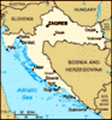Advertisement
Leaving Mostar was almost sad, because we had enjoyed the compact city as a group and on our own. We headed into the hills, where towns or villages lined the road for a considerable distance. Rain was falling for the whole drive. I noticed none of the un-recovered bombed houses we had seen on our way to Sarajevo from Mostar.
The border crossing into Croatia was old hat to us by now. Our driver, Paul today, gathered our passports (his on top) and presented them to an official inside, first the Bosnian booth and then the Croatian booth. We continued on through the mountains. The vegetation of low trees and tall bushes was later described to us as “Mediterranean bush”.
Our first stop was at the
Blue Lake, where we looked far down into an ancient sinkhole filled with stunning dark turquoise water. Our second stop was at the
Red Lake, also far down in an even larger sinkhole whose depth has not yet been discovered, because of its strange karst formation. Because the sky was grey cloud, the water did not reflect the reddish cliffs surrounding it and was as blue as the Blue Lake.
Retracing the road through
a large town, we were just in time to be stopped by a lot of school kids in small groups crossing the road to shop at the nearby bakery in their mid-morning break. Pedestrians have the right-of-way, so we waited perhaps five minutes, smiling at the friends chatting and scuffling.
About lunch-time we reached
Split, a city complete with suburbs and traffic jams. Since rain was still falling, we joined a crowd inside
Terminal F, a big port-side restaurant bar that usually accommodated its customers on a wide patio. We squeezed around one table and ordered pizza and burgers. My pulled-pork sandwich was delicious, not drowned in BBQ sauce, with coleslaw inside. The very salty, crispy fries were just right. Like Gary and Bill, I tried the local non-alcoholic beer and discovered that it is as good as the “real thing”.
We met our local guide outside, happy to continue our education, despite the now light rain. Directly in front of us was Diocletian’s gigantic retirement
palace . Built early in the fourth century, it has survived because of being adapted by change. In the seventh century, people built a town inside the walls. The Venetians expanded by breaking
through the west wall of the fort. A monumental church (
Cathedral of St Domnius) was built over the mausoleum of
Diocletian. Each of the three large altars was built in a different age. When I was waiting for the people to clear to let me take an unobstructed photo of the Baroque altar, I tried to ask a man just standing there to move to one side. Having no language in common, he thought I wanted a picture of him, and moved to the centre! After a few hopeless tries to motion him aside, I finally took his photo. When he wanted to see it, I had a moment of concern thinking he wanted payment, but all was well and he left, and I took the photo I wanted.
Across the way, was the baptistry for the church, which had been converted from Diocletian’s
Temple of Jupiter. The full-immersion pool was in the shape of a cross, quite small. Oddly, people throw money into it, presumably for good luck. In the excellent acoustics of the Palace's vestibule, a group of traditional Dalmatian singers gave us shivers with their harmonic, sad, powerful songs.
">Watch my video.
The palace's best-preserved area was the basement. Originally it had
a gate on the south wall to facilitate carrying materiel from the sea into the palace. The Venetians closed it off and closed off the whole basement under Diocletian’s home, thus preserving it almost intact until our times. Archaeologists have been able to understand how the palace was designed, because Romans built their basements in exact replica of the buildings above.
A short way from the Roman buildings in Split was the city of Trogir, where, on a small island, medieval and Venetian-era buildings have been preserved in almost a pristine state. On foot, we crossed from a busy road onto the island of old Trogir, still considered the city centre. Since it wasn’t raining, we turned our eyes away from the local market to visit on our own the large sand-coloured stone buildings that once were inhabited by rulers and leaders. A huge fortress dominated one end of the island town, a remnant of sea-faring power. A couple of ornate churches were the focal point on the other end of the island, a walk of less than ten minutes. Away from the strong winds of the sea, the medieval streets were uneven and polished bright by centuries of
foot steps. Perhaps inevitably, all the streets seemed to lead us to the market, filled with things we wouldn’t buy since we were on a tour.
Back on the road, we drove through even more mountainous regions and eventually joined a toll road for a speedy journey to Skradin, a small town with a lovely modern hotel. Our room were in a new section right on the sea; we ate our meals in the main hotel, across the road and up a hill, with a magnificent view. Dinner: beef broth with little noodles, excellent beet and lettuce salad, grilled Brown Trout, and chocolate crepes.
























Isabel Gibson
non-member comment
Amazing
What sinkholes! You couldn't loll around those lakes. The architecture is likewise amazingly beautiful - and, as you note, its survival to this day is a consequence of being able to stand being re-purposed. I loved the vestibule singers - great control. How people do that at all amazes me - without music to hold the note and the pace it's even more fantastic.